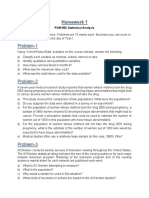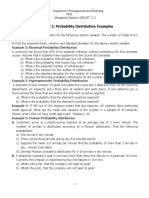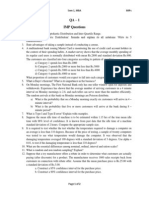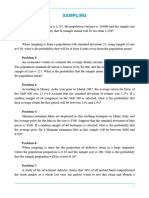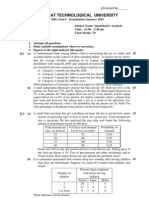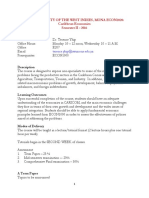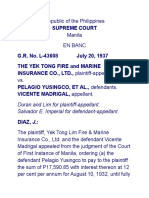Stat 2008
Stat 2008
Uploaded by
kobeCopyright:
Available Formats
Stat 2008
Stat 2008
Uploaded by
kobeOriginal Description:
Copyright
Available Formats
Share this document
Did you find this document useful?
Is this content inappropriate?
Copyright:
Available Formats
Stat 2008
Stat 2008
Uploaded by
kobeCopyright:
Available Formats
University of the West Indies
Department of Economics
ECON2008 – Statistical Methods I
Problem Set 1: Linear Combinations of Random Variables
and Discrete Random Variables
ALL ANSWERS ARE TO BE GIVEN TO AT LEAST 3 DECIMAL PLACES
Tutorial Questions
1. A rating company calculates and publishes various statistics concerning car quality. The initial quality
score measures the number of problems per new car sold. For 2002 model cars, the top brand had 0.85
problems per car. Let the random variable X be equal to the number of problems with a newly purchased
Lexus.
a) What type of random variable is this? Give reasons for your answer. What assumption(s) do you need
to make? Is/are your assumption(s) reasonable?
b) If you purchase this type of car, what is the probability that it has two problems or less?
2. An author receives from a publisher a contract, according to which she is to be paid a fixed sum of $10,000
plus $1.50 for each copy of her book sold. Her uncertainty about total sales of the book can be represented
by a random variable with mean 30,000 and standard deviation 8,000.
a) Find the mean of the total payment she will receive.
b) Find the standard deviation of the total payment she will receive.
3. An insurance company holds fraud insurance policies on 8000 firms. In any given year, the probability that
any single policy will result in a claim is 0.0005.
a) What type of random variable is this? Give reasons for your answer.
b) What option could you use to make the calculations of the probabilities for this random variable easier?
Give reasons for your answer.
c) Using your answer in b) as a guide, find the probability that at least three claims are made in a given
year.
1 ECON2008: STATISTICAL METHODS 1
PROBLEM SET 1
4. A corporation produces packages of paper clips. The number of clips per package varies, as indicated in
the accompanying table.
Number of Clips 47 48 49 50 51 52 53
Proportion of
0.04 0.13 0.29 0.21 0.20 0.03 0.10
Packages
a) Find the mean of the number of paper clips per package.
b) Find the standard deviation of the number of paper clips per package.
c) The cost (in cents) of producing a package of clips is 17+3X, where X is the number of clips in the
package. The revenue from selling the package, however many clips it contains, $2.00. If profit is
defined as the difference between revenue and cost, find the mean and standard deviation of profit per
package.
5. A hospital finds that 30% of its bills are at least one month in arrears. A random sample of 500 bills was
taken.
a) What type of random variable is this? Give reasons for your answer.
b) What is the probability that less than 200 bills in the sample were at least one month in arrears?
c) What is the probability that the number of bills in the sample at least one month in arrears was between
140 and 175 (inclusive)?
Extra Questions
1. The probability that a voter will believe a rumour about a politician is 0.25. Nineteen (19) voters are told
individually a rumour about a certain politician.
a) What type of random variable is this? Give reasons for your answer.
b) Three or more persons believe the rumour.
c) Determine the mean and standard deviation of the number who believe the rumour.
d) What is the probability that more than 18 do not believe the rumour.
2. Mamma Temte bakes six pies each day at a cost of $5 each. On 16% of the days she sells only two pies. On
32% of the days, she sells 4 pies, and on the remaining 52% of the days, she sells all six pies. If Mama
Temte sells her pies for $7 each, what is her expected profit for a day’s worth of pies? [Assume that any
leftover pies are given away.]
2 ECON2008: STATISTICAL METHODS 1
PROBLEM SET 1
3. In a large city, some commuters are finding that taking registered taxis to be a convenient, time-saving less
stressful alternative to taking the bus. While it is generally perceived as a safe mode of transportation, the
average number of deaths per week due to deaths from accidents involving registered taxis is 12, which is
surprisingly high.
a) What type of random variable is this? Give reasons for your answer.
b) How likely is it that 5 or less deaths due to accidents involving registered taxis will occur next week?
4. George Severn, a senior vice president, is responsible for production and sale of Nougy 93 Fruity Cereal.
Daily production has an average of 200 boxes with a variance of 625 boxes. On the other hand, total sales
has a mean of 200 boxes with a variance of 81 boxes. Sales and production are not independent and have a
correlation of 0.6. The selling price per box is $15. The variable production per box is $7 and the fixed
production costs total $250.
a) Calculate the expected profit for this company.
b) Calculate the standard deviation of the profit for this company.
5. A large manufacturing plant has 3,400 LED lightbulbs illuminating a factory floor. The mean rate of
failure for these bulbs is 4 bulbs per hour.
a) What type of random variable is this? Give reasons for your answer.
b) We want to find the probability that in an 8-hour shift no more than 15 bulbs will fail. What option
could you use to make the calculations of the probabilities for this random variable easier? Give
reasons for your answer.
c) Using your answer in b) as a guide, find the probability that in an 8-hour shift no more than 15 bulbs
will fail.
3 ECON2008: STATISTICAL METHODS 1
PROBLEM SET 1
You might also like
- Ap Stats CH 6 TestDocument6 pagesAp Stats CH 6 Testapi-2535798530% (1)
- Homework Assignment-1Document4 pagesHomework Assignment-1John Depasquale0% (1)
- Assignment IndividualDocument4 pagesAssignment IndividualPrakhar SrivastavaNo ratings yet
- Module 1 Final Wrap UpDocument4 pagesModule 1 Final Wrap UpTiffaniNo ratings yet
- Aon CorporationDocument17 pagesAon CorporationArun SharmaNo ratings yet
- HMRC Statement of Practice PDFDocument356 pagesHMRC Statement of Practice PDFchc011133No ratings yet
- Exercises_unit 6_discrete Probability Distributions (1)Document5 pagesExercises_unit 6_discrete Probability Distributions (1)kiuboartNo ratings yet
- Chapter 2: Probability Distribution ExamplesDocument4 pagesChapter 2: Probability Distribution ExamplesDawit MihiretNo ratings yet
- Problem Set 2 - Random Variables & Probability Distribution FunctionsDocument3 pagesProblem Set 2 - Random Variables & Probability Distribution FunctionsJuan Ignacio RamirezNo ratings yet
- Chapter 6Document14 pagesChapter 6ScribdTranslationsNo ratings yet
- IMT 24 Quantitative Techniques M1Document5 pagesIMT 24 Quantitative Techniques M1solvedcareNo ratings yet
- Revision MarketingAnalytics 20240129Document15 pagesRevision MarketingAnalytics 20240129Minh Tâm Trần100% (2)
- ps4 2015Document3 pagesps4 2015Sujit Srivastava0% (1)
- Statistics FinalReviewDocument8 pagesStatistics FinalReviewGaneshNo ratings yet
- Sample Final S12010Document7 pagesSample Final S12010Danielle CasamentoNo ratings yet
- Subject: E: Model Mis-Specification.: Conometric Problems RevisitedDocument4 pagesSubject: E: Model Mis-Specification.: Conometric Problems RevisitedShadman SakibNo ratings yet
- Practice Questions 2 - Opportunity Cost and TradeDocument9 pagesPractice Questions 2 - Opportunity Cost and TradeLokaNo ratings yet
- BS-II Assignment 1 Batch 2022 - 25 Sem 3 Date 29 Aug 2023Document3 pagesBS-II Assignment 1 Batch 2022 - 25 Sem 3 Date 29 Aug 2023Rakesh BiswalNo ratings yet
- Set 2 2022 Review QuestionsDocument12 pagesSet 2 2022 Review Questionsmailforjunkstuff22No ratings yet
- Assignment 6 Probability & Probability Distribution PDFDocument5 pagesAssignment 6 Probability & Probability Distribution PDFABCDNo ratings yet
- Chapter 3 - Random VariableDocument5 pagesChapter 3 - Random VariableMỹ KhanhhhNo ratings yet
- 1667750572final Assignment - ME06 BatchDocument8 pages1667750572final Assignment - ME06 BatchCalvin ManNo ratings yet
- Economics 101-300 Winter 2008 Final Examination Form 1 April 23, 2008Document14 pagesEconomics 101-300 Winter 2008 Final Examination Form 1 April 23, 2008Louie NaguitNo ratings yet
- Qa ImpsDocument2 pagesQa ImpsasifbhaiyatNo ratings yet
- QNT 561 Weekly Learning Assessments Answers - UOP StudentsDocument36 pagesQNT 561 Weekly Learning Assessments Answers - UOP StudentsUOP StudentsNo ratings yet
- PBT150S Tutorial Test 2 2024Document2 pagesPBT150S Tutorial Test 2 2024ntsodoambesiwe05No ratings yet
- ECO202 Practice NotesDocument2 pagesECO202 Practice NotesJames KrugerNo ratings yet
- Chapter 4 - SamplingDocument3 pagesChapter 4 - SamplingMỹ KhanhhhNo ratings yet
- Question PaperDocument4 pagesQuestion PapermahendrabpatelNo ratings yet
- Problems 1Document2 pagesProblems 1Rajiv KumarNo ratings yet
- Sample ExamDocument3 pagesSample ExamRJ DianaNo ratings yet
- QNT 561 Final Exam - QNT 561 Week 1 Practice Quiz 45 Questions - UOP StudentsDocument36 pagesQNT 561 Final Exam - QNT 561 Week 1 Practice Quiz 45 Questions - UOP StudentsUOP StudentsNo ratings yet
- March April 2010 Quantitative AnalysisDocument3 pagesMarch April 2010 Quantitative AnalysisMonika ShekhawatNo ratings yet
- 2nd Re-Exam in Finance - Questions 2015Document4 pages2nd Re-Exam in Finance - Questions 2015mrdirriminNo ratings yet
- Solution Chap 3Document7 pagesSolution Chap 3mad2kNo ratings yet
- Statistical Methods For Decision MakingDocument6 pagesStatistical Methods For Decision MakingjegadeeswariganapathyNo ratings yet
- Practice Set2Document7 pagesPractice Set2JAINAM JAINNo ratings yet
- Microeconomics Assignment, S1, 2016Document6 pagesMicroeconomics Assignment, S1, 2016Ayaan Khan100% (2)
- 2016 Fall Eco 2011 Assignment 01 CUHKDocument8 pages2016 Fall Eco 2011 Assignment 01 CUHKjamesNo ratings yet
- Eco100 Pesando Tt2 2010fDocument6 pagesEco100 Pesando Tt2 2010fexamkillerNo ratings yet
- Prob samplingDistOfMean2Document2 pagesProb samplingDistOfMean2Sauban AhmedNo ratings yet
- Specimen Long Quiz 1Document3 pagesSpecimen Long Quiz 1Ivan MilanesNo ratings yet
- Discrete Prob Practice QsDocument8 pagesDiscrete Prob Practice QsAitzul SchkohNo ratings yet
- Statistics Questions For HomeworkDocument2 pagesStatistics Questions For HomeworkJesha KihampaNo ratings yet
- Year 2.1Document11 pagesYear 2.1Tawanda Leonard CharumbiraNo ratings yet
- A3P2 For Posting PDFDocument4 pagesA3P2 For Posting PDFdingdong ditchNo ratings yet
- TBS2251 Business Statistical Analysis Lab 4: Probability DistributionDocument3 pagesTBS2251 Business Statistical Analysis Lab 4: Probability Distributionhi hiiNo ratings yet
- Tutorial 1-14 Student S Copy 201605Document27 pagesTutorial 1-14 Student S Copy 201605文祥0% (2)
- All group assignmentsDocument5 pagesAll group assignmentseinsteinbasit234No ratings yet
- Sem 2 Papers 2021 PDFDocument17 pagesSem 2 Papers 2021 PDFsahil sharmaNo ratings yet
- Izmir University of Economics Name & Last Name: Department of Economics, Fall 2013 Student ID #: ECON 101-Principles of MicroeconomicsDocument7 pagesIzmir University of Economics Name & Last Name: Department of Economics, Fall 2013 Student ID #: ECON 101-Principles of Microeconomicskahvesiz.dondurmaNo ratings yet
- Lab 2Document9 pagesLab 2Ahmad AlNo ratings yet
- Statistics FinalReviewDocument8 pagesStatistics FinalReviewWolf's RainNo ratings yet
- CaseStudiesStatistics 2009Document10 pagesCaseStudiesStatistics 2009sachy24No ratings yet
- 1010B (Tran) Ch1Document6 pages1010B (Tran) Ch1elfishsamurai147No ratings yet
- Economics Problem Sets Answer All QuestionsDocument8 pagesEconomics Problem Sets Answer All QuestionsSabir Ali0% (1)
- ECON 100 Assignment 1Document3 pagesECON 100 Assignment 1tahmeemNo ratings yet
- CBA: Practice Problem Set 7 Topics: 2 Sample Tests: Garage 1 Garage 2 MeanDocument2 pagesCBA: Practice Problem Set 7 Topics: 2 Sample Tests: Garage 1 Garage 2 MeanrahulNo ratings yet
- ECON 100 Assignment 1 PDFDocument3 pagesECON 100 Assignment 1 PDFtahmeemNo ratings yet
- ECON 3031 - Tutorial Sheet 3Document2 pagesECON 3031 - Tutorial Sheet 3kobeNo ratings yet
- UWI - ECON 2020 - Caribbean EconomiesDocument3 pagesUWI - ECON 2020 - Caribbean EconomieskobeNo ratings yet
- Terms ConditionsDocument13 pagesTerms ConditionskobeNo ratings yet
- NCB Account Opening Requirements For Jamaican ResidentsDocument1 pageNCB Account Opening Requirements For Jamaican ResidentskobeNo ratings yet
- Oscar PicazoDocument35 pagesOscar PicazoRudolf Christian Oliveras UgmaNo ratings yet
- Residence Expansiel.Document3 pagesResidence Expansiel.apoorvswarupNo ratings yet
- Search: Chanrobles On Line Bar ReviewDocument10 pagesSearch: Chanrobles On Line Bar ReviewMaria Celiña PerezNo ratings yet
- PNB v. Welch, Ffairchild, & Co., 44 Phil. 780 Part 2Document3 pagesPNB v. Welch, Ffairchild, & Co., 44 Phil. 780 Part 2SabjornNo ratings yet
- Data Analysis For InsuranceDocument16 pagesData Analysis For InsuranceDeloitte Analytics100% (1)
- HDFC Sampoorna Jeevan BrochureDocument25 pagesHDFC Sampoorna Jeevan BrochureLogeshParthasarathyNo ratings yet
- ID 193120001 Final Assignment.Document64 pagesID 193120001 Final Assignment.CSE 1033Naymur RahmanNo ratings yet
- Tally Tips - Accounting Heads of Incomes - ExpensesDocument12 pagesTally Tips - Accounting Heads of Incomes - ExpensescooNo ratings yet
- 6-1 Insurance CoveragesDocument14 pages6-1 Insurance CoveragesRavindi HandaragamaNo ratings yet
- Customer Satisfaction WRT Maruti CarsDocument69 pagesCustomer Satisfaction WRT Maruti Carsjogeshwar raoNo ratings yet
- Midwest Region Story PDFDocument1 pageMidwest Region Story PDFHECTOR IBARRANo ratings yet
- r44 Cadet Eoc 15 January 2024Document1 pager44 Cadet Eoc 15 January 2024Michael BarriosNo ratings yet
- Advanced Financial Accounting I Course OutlineDocument3 pagesAdvanced Financial Accounting I Course OutlineYani 28No ratings yet
- F6 Study Notes - Updated PDFDocument135 pagesF6 Study Notes - Updated PDFMandla DubeNo ratings yet
- FireinsuranceDocument9 pagesFireinsurancesmit9993No ratings yet
- Traditional Life Mock Exam ADocument15 pagesTraditional Life Mock Exam ABryan MorteraNo ratings yet
- Declaration Cum Indemnity Version 2.0 - tcm47-51647Document1 pageDeclaration Cum Indemnity Version 2.0 - tcm47-51647Bhausaheb Pankar0% (1)
- Half Yearly Xi BSTDocument4 pagesHalf Yearly Xi BSTJahnavi GoelNo ratings yet
- Indian POST Office Bank PresentationDocument26 pagesIndian POST Office Bank PresentationDharmender SinghNo ratings yet
- LIC Assistant Mains 2019 MCQDocument9 pagesLIC Assistant Mains 2019 MCQWasif FayazNo ratings yet
- Aviation Insurance by Barbara H. WoodwardDocument16 pagesAviation Insurance by Barbara H. Woodward'Shahbaz Ahmed'No ratings yet
- List Insurance CompaniesDocument3 pagesList Insurance CompaniesdnielprasetyoNo ratings yet
- A5 Valuation OutlinesDocument124 pagesA5 Valuation OutlinesThiện Trần ĐứcNo ratings yet
- Bank Guarantees in IndiaDocument30 pagesBank Guarantees in IndiaGajendra Bhansali0% (1)
- Yek Tong Lin Fire vs. YusingcoDocument20 pagesYek Tong Lin Fire vs. YusingcoSherwin Anoba CabutijaNo ratings yet
- Banking and InsuranceDocument3 pagesBanking and InsuranceTEEN TECH NLEFNo ratings yet
- A Human Rights-Based Approach To Universal Health Coverage in The PhilippinesDocument12 pagesA Human Rights-Based Approach To Universal Health Coverage in The PhilippinesADB Health Sector Group100% (1)
- The Travelers Indemnity Company v. United States of America For The Use of Construction Specialties Company, 382 F.2d 103, 10th Cir. (1967)Document4 pagesThe Travelers Indemnity Company v. United States of America For The Use of Construction Specialties Company, 382 F.2d 103, 10th Cir. (1967)Scribd Government DocsNo ratings yet

